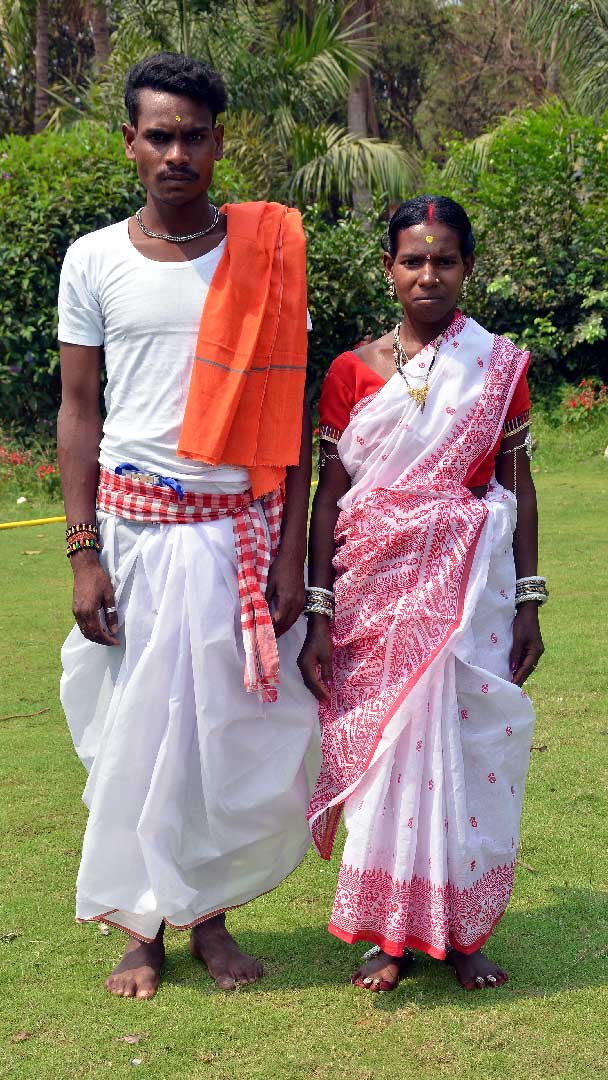TRIBES OF ODISHA
TRIBES OF ODISHA
Hill Kharia
Pahari Kharia
Population*: 1,908
Map: Click Here
Origin: The Kharia are believed to have migrated to the region from river valleys north of the Vindhya and Kairmur ranges.
Culture and Crafts: The group identifies itself as descendents of Visavasu Sabara, the first worshipper of Lord Jagannath. Festivals are celebrated with music and dance, the primary instrument being the Changu. Jumar is a popular dance among the Hill Kharia and cock fighting is a popular entertainment for the youth.
Occupation: The traditional occupation of the Kharia was to till the soil and carry palanquins, locally known as Kharkharia. The tribe is split into three groups; the Hill Kharia being the most primitive still survive as hunter-gatherers. Forest produce such as resin, honey and tussar cocoons forms their major source of income. Cultivation is done on small patches of land, or as agricultural labor. Women also weave date palm and bamboo mats and leaf plates and cups are made for personal use and sale in local markets. Rope making of siali and jute is also a common occupation.
*Scheduled Tribes Population as per Census 2011 data. PVTGs Population as per Micro Project Survey Data, 2010
Hill Kharia
Pahari Kharia
Population*: 1,908
Map: Click Here
Origin: The Kharia are believed to have migrated to the region from river valleys north of the Vindhya and Kairmur ranges.
Culture and Crafts: The group identifies itself as descendents of Visavasu Sabara, the first worshipper of Lord Jagannath. Festivals are celebrated with music and dance, the primary instrument being the Changu. Jumar is a popular dance among the Hill Kharia and cock fighting is a popular entertainment for the youth.
Occupation: The traditional occupation of the Kharia was to till the soil and carry palanquins, locally known as Kharkharia. The tribe is split into three groups; the Hill Kharia being the most primitive still survive as hunter-gatherers. Forest produce such as resin, honey and tussar cocoons forms their major source of income. Cultivation is done on small patches of land, or as agricultural labor. Women also weave date palm and bamboo mats and leaf plates and cups are made for personal use and sale in local markets. Rope making of siali and jute is also a common occupation.
*Scheduled Tribes Population as per Census 2011 data. PVTGs Population as per Micro Project Survey Data, 2010
Hill Kharia
Pahari Kharia
Population*: 1,908
Map: Click Here
Origin: The Kharia are believed to have migrated to the region from river valleys north of the Vindhya and Kairmur ranges.
Culture and Crafts: The group identifies itself as descendents of Visavasu Sabara, the first worshipper of Lord Jagannath. Festivals are celebrated with music and dance, the primary instrument being the Changu. Jumar is a popular dance among the Hill Kharia and cock fighting is a popular entertainment for the youth.
Occupation: The traditional occupation of the Kharia was to till the soil and carry palanquins, locally known as Kharkharia. The tribe is split into three groups; the Hill Kharia being the most primitive still survive as hunter-gatherers. Forest produce such as resin, honey and tussar cocoons forms their major source of income. Cultivation is done on small patches of land, or as agricultural labor. Women also weave date palm and bamboo mats and leaf plates and cups are made for personal use and sale in local markets. Rope making of siali and jute is also a common occupation.
*Scheduled Tribes Population as per Census 2011 data. PVTGs Population as per Micro Project Survey Data, 2010
Hill Kharia
Pahari Kharia
Population*: 1,908
Map: Click Here
Origin: The Kharia are believed to have migrated to the region from river valleys north of the Vindhya and Kairmur ranges.
Culture and Crafts: The group identifies itself as descendents of Visavasu Sabara, the first worshipper of Lord Jagannath. Festivals are celebrated with music and dance, the primary instrument being the Changu. Jumar is a popular dance among the Hill Kharia and cock fighting is a popular entertainment for the youth.
Occupation: The traditional occupation of the Kharia was to till the soil and carry palanquins, locally known as Kharkharia. The tribe is split into three groups; the Hill Kharia being the most primitive still survive as hunter-gatherers. Forest produce such as resin, honey and tussar cocoons forms their major source of income. Cultivation is done on small patches of land, or as agricultural labor. Women also weave date palm and bamboo mats and leaf plates and cups are made for personal use and sale in local markets. Rope making of siali and jute is also a common occupation.
*Scheduled Tribes Population as per Census 2011 data. PVTGs Population as per Micro Project Survey Data, 2010
PVTG Communities
62 Scheduled Tribes
PVTG Communities
62 Scheduled Tribes
PVTG Communities
62 Scheduled Tribes





